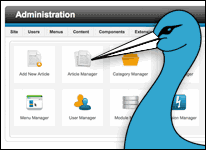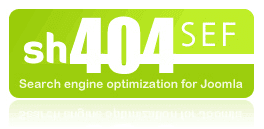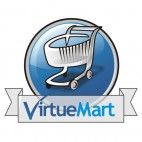The Joomlashack Blog
HikaShop - Ecommerce for Joomla
- Written by Ed Andrea Ed Andrea
- Published: 08 December 2011 08 December 2011
HikaShop is a relatively new shopping cart for Joomla. It's becoming a strong competitor to Virtuemart, and we're starting to get more and more questions about it from students. HikaShop comes in both a free version and two levels of commercial versions.
Since HikaShop is fully integrated with Joomla, you can get started very quickly. However, you do have to learn some new ideas on how to enter products. In this tutorial we'll show you everything you'll need to get up and running with HikaShop.
You can also read our tutorials on other Joomla ecommerce solutions: Virtuemart, RokQuickCart, SimpleCaddy, K2Mart and building a custom cart.
If you want to go further, we have a 20 video training class on Hikashop.
The Ultimate Joomla Admin Templates Guide
- Written by Ed Andrea Ed Andrea
- Published: 30 November 2011 30 November 2011
 The current Joomla admin template called Blue Stork has improvements over the 1.5 version, but that doesn't mean it can't be improved as well.
The current Joomla admin template called Blue Stork has improvements over the 1.5 version, but that doesn't mean it can't be improved as well.
Joomla 1.6 / 1.7 is the first version to ship with more than one design for the admin area - it included Hathor in addition to Blue Stork. Several template designers have also created templates that aim to make it easier to use, look more attractive and have additional functionality.
In this guide we're going to show you all of the options that you have for redesigning your Joomla admin area.
How to Use the Gantry Framework for Joomla
- Written by Ed Andrea Ed Andrea
- Published: 24 November 2011 24 November 2011
Gantry is a very popular design framework that is available for both Joomla and WordPress. It is built on a 12 column, 960 Grid System layout (you can find out more about grid systems here).
All Rockettheme templates and themes are now based on Gantry because it offers a wide-range of features that don't have to be re-written for each design. Because of this, not only Rockettheme, but also quite a few independent designers use Gantry to speed up their work.
New Designer, New Joomla 1.7 Template
- Written by Joomlashack Joomlashack
- Published: 17 November 2011 17 November 2011

We're excited to welcome designer Paola Gomez to the Joomlashack family. Paola has over 10 years experience in graphic design including 5 working at the world-renowned and high-paced DDB ad agency. Although not 100% her design, Paola worked extensively on this template. It was a work in progress when she found it and she completed and polished into this elegant and minimalist business-themed template. The result, as you can agree, is awesome.
Meet Argos, our newest Joomla 1.7 Template. Argos is built using versatile and dynamic Wright Framework.
How to Use sh404SEF for Joomla
- Written by Ed Andrea Ed Andrea
- Published: 16 November 2011 16 November 2011
 For years sh404SEF has been an important SEO extension for Joomla. It handles your URLs, your metadata and has even started to add features such as security, analytics and QR codes.
For years sh404SEF has been an important SEO extension for Joomla. It handles your URLs, your metadata and has even started to add features such as security, analytics and QR codes.
The purpose of this tutorial is to get you started with a quick setup and enough skill to manage sh404SEF successfully. A note before we start: this is a commercial extension.
SP Upgrade for Joomla 1.5 to 2.5 Migration
- Written by Ed Andrea Ed Andrea
- Published: 08 November 2011 08 November 2011
 Now here's a strange coincidence ... while I was writing this tutorial, one of my sites got hacked because it wasn't updated. I had neglected to update my site because it involves downloads and uploads and who has time for that? Well I should have taken the time. I learned my lesson, and I'm getting ready for the future.
Now here's a strange coincidence ... while I was writing this tutorial, one of my sites got hacked because it wasn't updated. I had neglected to update my site because it involves downloads and uploads and who has time for that? Well I should have taken the time. I learned my lesson, and I'm getting ready for the future.
With Joomla 2.5 the upgrades are much easier, so I've decided to migrate all my Joomla sites to 2.5. There is a simple, new tool for making the transition, and it works - SP Upgrade. You may not need to do this today, but when that day eventually arrives, this tutorial will help you make this transition very smoothly. A note before we start: this extension is commercial. If you're looking for a free alternative, try our tutorial on jUpgrade.
VirtueMart - eCommerce for Joomla
- Written by Ed Andrea Ed Andrea
- Published: 02 November 2011 02 November 2011
 VirtueMart is absolutely huge. By some counts, it stands second in popularity amongst all eCommerce platforms.
VirtueMart is absolutely huge. By some counts, it stands second in popularity amongst all eCommerce platforms.
Right now the VirtueMart team is getting ready to launch VirtueMart Version 2.0 for Joomla 1.7. So this is a great opportunity to give you an introductory tutorial.
VirtueMart comes with a lot of flexibility and there are also many additional extensions available. Get started with the following tutorial. Afterwards you can move on to more advanced features and extensions with confidence.
How to Clear the Cache in Joomla
- Written by Ed Andrea Ed Andrea
- Published: 25 October 2011 25 October 2011
We get asked this question quite often. Usually someone is trying to change something in their admin section, they go to the site to preview the changes and - NOTHING'S CHANGED!
That usually leads to varying amounts of hair pulling and frustrated searching around for answers. However, the solution is pretty simple once you know how to manage cache.
SobiPro - The Missing Documentation
- Written by Ed Andrea Ed Andrea
- Published: 21 October 2011 21 October 2011
 SobiPro is a great Joomla extension. It allows you to create completely custom displays for the information you need.
SobiPro is a great Joomla extension. It allows you to create completely custom displays for the information you need.
Let's take an example. You buy, sell or make guitars and you need to build a catalog to show them. You're going to have someone type in your product list with all sorts of information that is specific to your guitars. A basic Joomla article simply has a title and a body, with no special fields for the price, the manufacturer or other information that is vital for your customers.
SobiPro is called a Content Construction Kit (CCK) because it allows you to construct the content that you want. It allows you to create a custom display for the information you need. We've also written documentation for K2 which is another Joomla CCK.
Help, My Joomla Username and Password Don't Match!
- Written by Ed Andrea Ed Andrea
- Published: 21 October 2011 21 October 2011
Has this happened to you? You try to login and suddenly your username and password don't match.
Well, it happened to me three times this week, and after doing a little research I found that this happens more often than it should.
In this tutorial we'll show you how to fix it, and in the process, you will learn how to enable and disable plugins using phpMyAdmin when you can't get to your Joomla Admin panel.
Read more: Help, My Joomla Username and Password Don't Match!
